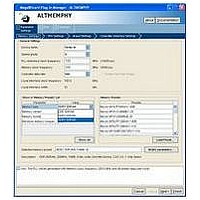IPR-HPMCII Altera, IPR-HPMCII Datasheet - Page 72

IPR-HPMCII
Manufacturer Part Number
IPR-HPMCII
Description
IP CORE Renewal Of IP-HPMCII
Manufacturer
Altera
Datasheet
1.IP-HPMCII.pdf
(176 pages)
Specifications of IPR-HPMCII
Software Application
IP CORE, Memory Controllers, SDRAM
Supported Families
Arria II GX, HardCopy III, Stratix III, Stratix IV
Core Architecture
FPGA
Core Sub-architecture
Arria, HardCopy, Stratix
Rohs Compliant
NA
Lead Free Status / RoHS Status
na
- Current page: 72 of 176
- Download datasheet (4Mb)
5–20
External Memory Interface Handbook Volume 3
Section II. DDR3 SDRAM Controller with ALTMEMPHY IP User Guide
Read Data Alignment
Data alignment is the process controlled by the sequencer to ensure the correct
captured read data is present in the same half-rate clock cycle at the output of the read
data DPRAM. Data alignment is implemented using memory blocks in the core of
devices.
Postamble Protection
A dedicated postamble register controls the gating of the shifted DQS signal that
clocks the DQ input registers at the end of a read operation. Any glitches on the DQS
input signals at the end of the read postamble time do not cause erroneous data to be
captured as a result of postamble glitches. The postamble path is also calibrated to
determine the correct clock cycle, clock phase shift, and delay chain settings.
Stratix III and Stratix IV Devices
The DDR3 SDRAM controller asserts ctl_doing_rd to indicate that a read command
is requested. The ctl_doing_rd signal is then used for the following purposes:
■
■
■
The DDR3 SDRAM ALTMEMPHY then asserts the ctl_rdata_valid signal to
indicate that the data on the read data bus is valid. The ctl_rdata_valid signal is two
bits wide to allow controllers to issue reads and writes that are aligned to either the
half-cycle of the half-rate clock.
When calibration is over, the read latency of the PHY (the ctl_rlat signal) is sent
back to the controller to indicate how long it takes in ctl_clk clock cycles from
assertion of the ctl_doing_read signal to the valid read data returning on the
ctl_rdata bus. The ctl_rlat signal is only valid when calibration has successfully
completed and never changes values during normal user mode operation.
The read datapath for DDR3 SDRAM consists of two main blocks:
■
■
As the DQS/DQSn signal is not continuous, the PHY also has postamble protection
logic to ensure that any glitches on the DQS input signals at the end of the read
postamble time do not cause erroneous data to be captured as a result of postamble
glitches.
Control of the postamble circuit
Generation of ctl_rdata_valid from one bit to two bits
Dynamic OCT control timing
Read data capture, resynchronization, and demultiplexing (in the dp_io_siii
module)
Read data alignment logic (in the read_dp module) to transfer data from the
resync_clk_2x (half-rate resynchronization) clock domain to the phy_clk clock
domain.
Chapter 5: Functional Description—ALTMEMPHY
December 2010 Altera Corporation
Block Description
Related parts for IPR-HPMCII
Image
Part Number
Description
Manufacturer
Datasheet
Request
R

Part Number:
Description:
IP NIOS II MEGACORE RENEW
Manufacturer:
Altera
Datasheet:

Part Number:
Description:
IP CORE Renewal Of IP-XAUIPCS
Manufacturer:
Altera
Datasheet:

Part Number:
Description:
IP CORE Renewal Of IP-10GETHERNET
Manufacturer:
Altera
Datasheet:

Part Number:
Description:
IP CORE Renewal Of IP-ASI
Manufacturer:
Altera
Datasheet:

Part Number:
Description:
IP CORE Renewal Of IP-CIC
Manufacturer:
Altera
Datasheet:

Part Number:
Description:
IP CORE Renewal Of IP-CRC
Manufacturer:
Altera
Datasheet:

Part Number:
Description:
IP CORE Renewal Of IP-ED8B10B
Manufacturer:
Altera
Datasheet:

Part Number:
Description:
CPLD, EP610 Family, ECMOS Process, 300 Gates, 16 Macro Cells, 16 Reg., 16 User I/Os, 5V Supply, 35 Speed Grade, 24DIP
Manufacturer:
Altera Corporation
Datasheet:

Part Number:
Description:
CPLD, EP610 Family, ECMOS Process, 300 Gates, 16 Macro Cells, 16 Reg., 16 User I/Os, 5V Supply, 15 Speed Grade, 24DIP
Manufacturer:
Altera Corporation
Datasheet:

Part Number:
Description:
Manufacturer:
Altera Corporation
Datasheet:










